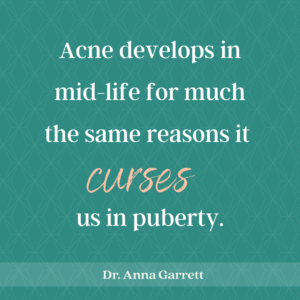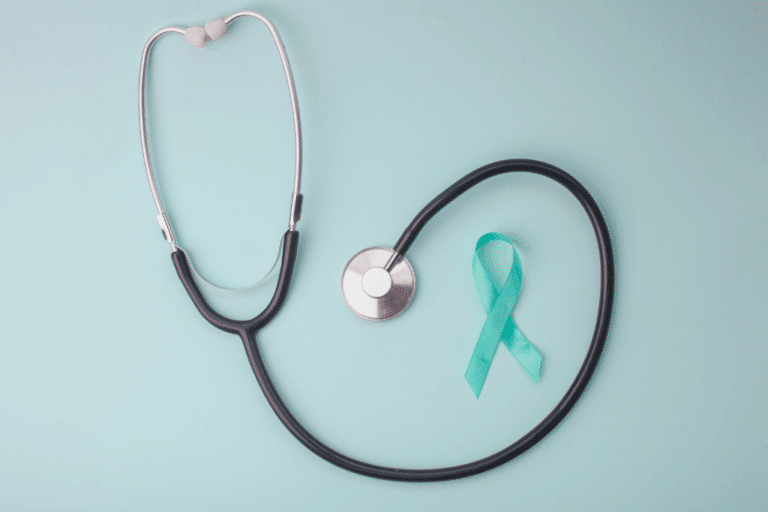Acne in midlife? What???
Skin changes during perimenopause and menopause can be both uncomfortable and distressing. Hormonal changes, stress, genetics, and diet, just to name a few, are possible culprits.
 It is often hard to narrow down acne to a single root cause. Acne develops in women in midlife for much the same reasons that it curses us in puberty. The changes and imbalances in hormone levels during this stage of life impact our skin’s natural defenses and trigger acne.
It is often hard to narrow down acne to a single root cause. Acne develops in women in midlife for much the same reasons that it curses us in puberty. The changes and imbalances in hormone levels during this stage of life impact our skin’s natural defenses and trigger acne.
In most cases, adult acne is caused by hormonal imbalances in which the body produces too much androgen (male sex hormones) or increased sensitivity to normal levels of androgen at the level of the skin. In addition, anything that compromises the immune system, whether it is emotional stress or nutritional deficiency, is likely to upset your cortisol and insulin balance, which can affect your skin.
Let’s Look at The More Common Causes of Acne:
Diet
The exact role between diet and hormonal acne isn’t fully understood. Some foods may help prevent acne, particularly inflammation-fighting foods. Plant-based foods high in antioxidants may help reduce inflammation and promote clearer skin. Omega-3 fatty acids may also decrease skin inflammation.
Contrary to popular belief, junk food alone doesn’t cause acne. But overdoing it on certain foods may lead to increased inflammation.
You may consider limiting the following:
- sugar
- dairy products
- refined carbs, such as white bread and pasta
- red meats
Hormone Imbalances
The defining characteristic of hormonal acne is deep, tender bumps or cysts, mainly around the mouth, chin, and jawline. (This, in contrast to regular acne, looks like blackheads, whiteheads, and pus-filled bumps on oily areas of the face, like the T-zone.) Another tell-tale sign that you’re dealing with menopausal acne? It often manifests along with excess facial hair, especially on the chin and upper lip.
Falling levels of estrogen throw off the delicate balance of androgens, most specifically testosterone. As estrogen levels fall, the relative increase of testosterone results in oily skin and clogged pores. That spike of testosterone also causes increased facial hair growth and is why this type of acne shows up on the lower face, as it seems that this is where more androgen receptors live.
Add to this the fact that some women are more prone to androgenic symptoms because of the body’s preference for the 5-alpha pathway for testosterone and DHEA metabolism. This increases the likelihood of acne, oily skin, and hair loss. Balancing hormones and blocking the 5-alpha pathway is ultimately the best way to both prevent and treat menopausal acne. A DUTCH test can determine whether your body prefers the 5-alpha metabolic pathway for testosterone and DHEA metabolism. Knowing this can help your clinician choose the right approach to reduce your acne.
Stress
Stress due to the many other changes happening within the body also contributes to acne. Along with impacting hormone levels in general, stress increases cortisol in the body. It wreaks havoc on the skin in many ways, triggering breakouts through increased oil production being just one of them. While it’s obviously easier said than done, attempting to reduce stress as much as possible during, before, and after menopause is critical.
Gut Health
One often overlooked culprit for acne is the gut. Not only is skin the largest organ in the body, but it also is an outward reflection of your internal state. A leaky gut, which happens when the gut is inflamed, allows food that’s not completely digested to enter your bloodstream, leading to breakouts.
An imbalance of microbes can also lead to acne, as can issues with low stomach acid. A GI Map test can help identify leaky gut as well as imbalances in microbes. Some data suggest oral probiotic supplements can help restore a healthy balance of good bacteria, reduce inflammation, and improve skin quality. Adding more gut-healthy prebiotics, healthy fat and fermented foods can help fight breakouts.
Managing Hormonal Acne
Prescription drugs
There are a number of ways to control hormonal acne. Anti-androgen drugs work by decreasing androgens (DHEA and testosterone). Spironolactone (Aldactone) is primarily used to treat high blood pressure, but it also has anti-androgen effects. In other words, it can prevent your body from producing more androgen and allow your hormone levels (and acne) to stabilize.
Birth control pills are commonly used for acne, but they have a number of downsides, such as gut microbe disruption and depletion of B vitamins.
Topical agents, such as retinoids, may help if acne is mild but are unlikely to help with cystic acne.
Natural alternatives
Saw palmetto is an herb that is often used for male prostate problems. It blocks the 5-alpha pathway, and so it is also effective in women who are affected by hormonal acne.
Tea tree oil
Tea tree oil works by decreasing inflammation that can contribute to acne. One study found that 5 percent topical tea tree oil relieved symptoms in participants with mild to moderate acne. Tea tree oil is available in many skincare products, such as cleansers and toners. You can also use tea tree essential oil as a spot treatment (be sure to dilute in a carrier oil).
Alpha hydroxy acid
Alpha hydroxy acids (AHAs) are plant acids derived mostly from citrus fruits. AHAs can help remove excess dead skin cells clogging pores. As a bonus, AHAs can help minimize the appearance of acne scars. AHA can be found in many OTC masks and creams. As with retinoids, AHAs can increase your skin’s sun sensitivity. You should always wear sunscreen when using products with AHA.
Green tea
Green tea is known for decreasing inflammation in the body. For a more holistic approach to acne, consider drinking a few cups per day besides practicing your topical skin care regimen. You can find a great selection of green teas here. Lotions and gels containing at least 2 percent green tea extract may also be beneficial.
Bottom Line
Overall, the good news is that are some natural alternatives other than prescription medicine for women who prefer the do-it-yourself approach. However, if you are struggling to determine the reason for your recent breakouts, it may be time for expert help. You can get more information about how I can help you at www.drannagarrett.com/connect-the-dots.
Dr. Anna Garrett is a menopause expert and Doctor of Pharmacy. She helps women who are struggling with symptoms of perimenopause and menopause find natural hormone balancing solutions so they can rock their mojo through midlife and beyond. Dr. Anna is the author of Perimenopause: The Savvy Sister’s Guide to Hormone Harmony. Order your copy at www.perimenopausebook.com.
Dr. Anna is available for 1-1 consultation. Find out more at www.drannagarrett.com/lets-talk




